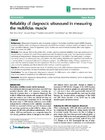| dc.contributor.author | Skeie, Eirik Johan | |
| dc.contributor.author | Borge, Jan Arve | |
| dc.contributor.author | Leboeuf-Yde, Charlotte | |
| dc.contributor.author | Bolton, Jennifer | |
| dc.contributor.author | Wedderkopp, Niels | |
| dc.date.accessioned | 2019-02-21T16:22:46Z | |
| dc.date.available | 2019-02-21T16:22:46Z | |
| dc.date.issued | 2015 | |
| dc.identifier.citation | Skeie, E. J., Borge, J. A., Leboeuf-Yde, C., Bolton, J. and Wedderkopp, N., 2015. Reliability of diagnostic ultrasound in measuring the multifidus muscle. Chiropractic and Manual Therapies, 23:15 https://doi.org/10.1186/s12998-015-0059-6 | en |
| dc.identifier.issn | 2045-709X | |
| dc.identifier.uri | https://aecc.archive.knowledgearc.net/handle/123456789/55 | |
| dc.description | Available under License - Creative Commons Attribution: https://creativecommons.org/licenses/by/4.0/ | en |
| dc.description.abstract | Background: Ultrasound is frequently used to measure activity in the lumbar multifidus muscle (LMM). However
previous reliability studies on diagnostic ultrasound and LMM have included a limited number of subjects and few
have used Bland-Altman’s Limits of Agreement (LOA). Further one does not know if activity affects the subjects’
ability to contract the LMM.
Methods: From January 2012 to December 2012 an inter- and intra-examiner reliability study was carried out in a
clinical setting. It consisted of a total of four experiments with 30 subjects in each study. Two experienced examiners
performed all measurements. Ultrasound measurements were made of: 1. the LMM in the resting state, 2. during a
contracted state, 3. on subsequent days, and, before and after walking. Reliability and agreement was tested for
1. resting LMM, 2. contracted LMM, and 3. thickness change in the LMM. Mean values of three measurements
were used for statistical analysis for each spinal level. The intra-class correlation coefficient (ICC) 3.1 and 3.2 was
used to test for reliability, and Bland-Altman’s LOA method to test for agreement.
Results: All of the studies indicate high levels of reliability, but as the LMM thickness increased (increasing
contraction) the agreement between examiners was poorer than for low levels of contraction.
Conclusions: The use of diagnostic ultrasound to measure the LMM seems to be reliable in subjects who have
little or no change in thickness of the LMM with contraction. | en |
| dc.language.iso | en | en |
| dc.publisher | Chiropractic and Manual Therapies | en |
| dc.title | Reliability of diagnostic ultrasound in measuring the multifidus muscle | en |
| dc.type | Article | en |
| dc.identifier.doi | https://doi.org/10.1186/s12998-015-0059-6 | |
